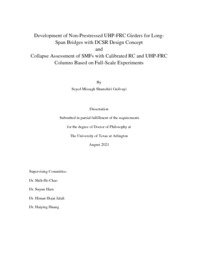
ATTENTION: The works hosted here are being migrated to a new repository that will consolidate resources, improve discoverability, and better show UTA's research impact on the global community. We will update authors as the migration progresses. Please see MavMatrix for more information.
Show simple item record
| dc.contributor.advisor | Chao, Shih-Ho | |
| dc.creator | Shamshiri Guilvayi, Seyed Missagh | |
| dc.date.accessioned | 2023-06-27T20:55:04Z | |
| dc.date.available | 2023-06-27T20:55:04Z | |
| dc.date.created | 2021-08 | |
| dc.date.issued | 2021-08-06 | |
| dc.date.submitted | August 2021 | |
| dc.identifier.uri | http://hdl.handle.net/10106/31339 | |
| dc.description.abstract | The work presented here is divided in two parts. This summary includes two paragraphs, each summarizing the topics presented in this dissertation.
Ultra-high-performance fiber-reinforced concrete (UHP-FRC) is an emerging material and revolutionarily utilize its mechanical properties can offer a new way to design conventional precast prestressed concrete girders. Its ultra-high compressive strength (> 20 ksi) accompanying by exceptional compressive ductility with a maximum useable compressive strain of 0.015–0.03 allow designers to use higher amount of reinforcement. Current design codes (ACI 318 Building Code and AASHTO LRFD Bridge Design Specifications), limits the maximum useable compressive strain, εcu, to 0.003 for conventional plain concrete to assure the ductile failure of the member. This limitation leads to a section with smaller amount of reinforcement and more vulnerable to cracking and corrosion. Part one of this study investigates an innovative design concept – ductile-concrete strong-reinforcement (DCSR) for designing long-span UHP-FRC bridge girders without prestressing. This new design concept eliminates the use of prestress through enhancing the flexural first cracking strength by using high amount of non-prestressed corrosion and fatigue resistance ASTM A1035 rebars. This allows the elimination of prestressing. The uncracked section maintains the stiffness of the section under service loading and consequently the well-controls the deflection. Even after cracks occur, the combination of high amount of reinforcement with fiber bridging considerably prevents the crack development and propagation. This keeps the section stiffness nearly unchanged up to very high loads. The high amount of reinforcement not only considerably increases the flexural capacity of the girder, the small stresses in rebars also help close the cracks if overload occurs. Experimental testing shows beams design by DCSR concept showing high ductility due to UHP-FRC’s exceptional compressive ductility. UHP-FRC’s high shear strength also allow the shear reinforcement to be minimized or eliminated. Long-span bridges with different lengths were designed and illustrated using DCSR concept with optimized sections.
In the second part of this dissertation, a commonly used energy-based degradation model for reinforced concrete (RC) columns were examined against recent full-scale column testing results. The experimental tests consisted of five identical full-scale ACI 318 compliant RC columns subjected to various loading protocols up to collapse. The results indicate that currently used energy-based deterioration hysteretic models cannot accurately predict the behavior of RC columns subjected to different loading protocols. The test result analysis shows that when the P-Delta effect is removed, there is no evidence of negative stiffness due to in-cycle degradation resulting from material nonlinearities in the response even up to large drift ratios (DR > 10%). Another drawback of current model is that it needs to be recalibrated for different loading protocols. A new dual degrading model (DDM) is proposed for modeling the nonlinear behavior of RC columns subjected to collapse level displacement reversals. This model features a dual degrading system at the plastic hinge for predicting the behavior of an RC column under different loading histories. DDM can be calibrated by multiple loading protocols simultaneously with only one set of parameters. This increases the accuracy and confidence of the model for predicting a structure’s seismic behavior. The new dual degrading model is shown capable of matching the behavior of the full-scale test results up to collapse level drift ratios. Then, the new model is applied to prototype four-story and 20-story RC buildings analyzed by nonlinear time-history analyses. For the four-story building, results indicate an appreciable difference in the seismic response in term of maximum drift ratio as compared to the analysis using the conventional energy-based degradation model. These effects become significant where the ground motion intensity is scaled up for collapse simulations. Incremental dynamic analyses (IDA) indicate that the predicted collapse resistance for low rise frames can have a 10% difference between the seismic force resisting system (SFRS) with DDM and conventional energy-based degradation model. This difference becomes insignificant for high-rise buildings as the collapse drift ratio level for them is generally in smaller levels where the plastic hinge models exhibit similar behavior. | |
| dc.format.mimetype | application/pdf | |
| dc.language.iso | en_US | |
| dc.subject | UHPFRC | |
| dc.subject | Non-prestressed girders | |
| dc.subject | RC | |
| dc.subject | Collapse | |
| dc.title | DEVELOPMENT OF NON-PRESTRESSED UHP-FRC GIRDERS FOR LONG-SPAN BRIDGES WITH DCSR DESIGN CONCEPT AND COLLAPSE ASSESSMENT OF SMFS WITH CALIBRATED RC AND UHP-FRC COLUMNS BASED ON FULL-SCALE EXPERIMENTS | |
| dc.type | Thesis | |
| dc.date.updated | 2023-06-27T20:55:05Z | |
| thesis.degree.department | Civil Engineering | |
| thesis.degree.grantor | The University of Texas at Arlington | |
| thesis.degree.level | Doctoral | |
| thesis.degree.name | Doctor of Philosophy in Civil Engineering | |
| dc.type.material | text | |
| local.embargo.terms | 2023-08-01 | |
| local.embargo.lift | 2023-08-01 | |
Files in this item
- Name:
- SHAMSHIRIGUILVAYI-DISSERTATION ...
- Size:
- 26.21Mb
- Format:
- PDF
This item appears in the following Collection(s)
Show simple item record


